Garden Design Projects in East and West Sussex
We have compiled a selection of Rumbold–Ayers' most recent garden designs project in East and West Sussex: click on the “read more” links below to see the full story:Wildlife Landscaping, Crawley, West Sussex
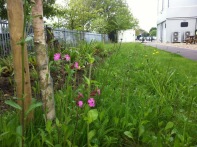 Summary: Wildlife-firendly garden design, commercial site
Summary: Wildlife-firendly garden design, commercial siteLocation: West Sussex
Scope of work: Landscape and planting plans, setting-out and planting assistance, Maintenance Specifications
.jpg) introduction
introduction
The client company was planning a major office space expansion and, following the success of our earlier wildlife-friendly landscape design (see below), decided to include a suitable native planting scheme as part of the project.
the brief
Rumbold-Ayers were appointed by the client's consultants Darwin Ecology to detail the proposed native tree, shrub, and perennial planting around the periphery of the site.
design considerations
The main design considerations for the planting were:
- to create a pleasant and visually pleasing environment around the office space
- to encourage wildlife by using only native species
- to maximise wildlife value by creating a contiguous wildlife corridoor
- to avoid impeding sightlines from security cameras.
The design included native hedge planting to soften the visual impact of the galvanised railings around the site, and log piles to encourage invertebrates. Shade trees were included, both to create a variety of habitats and to form an attractive setting for picnic tables for use by staff at lunchtime.
The planting extended around three sides of the office building, and also around the car park. Shade planting included Carex pendula, Digitalis purpurea, Iris foetidissima, Dryopteris felix-mas, Aconitum napellus and Geraniums, whilst gravel planting around the car park areas included Rosmarinus officinalis, Ruscus aculeatus, Euphorbia lathyris, Lavandula angustifolia, Cytisus scoparius and Carex pendula.
- completed Nov 2012
Commercial Landscaping, Crawley, West Sussex
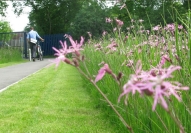 Summary: Wildlife garden design, office grounds
Summary: Wildlife garden design, office groundsLocation: West Sussex
Scope of work: Landscape and planting plans, advice on plant supply
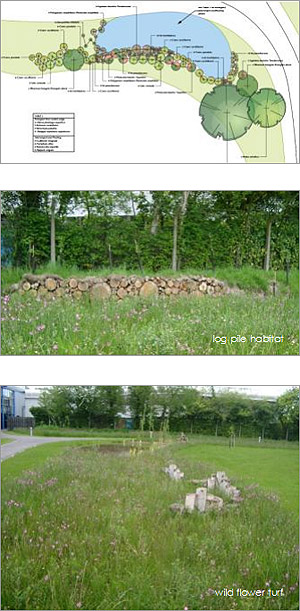 introduction
introduction
The client was keen to improve the recreational space adjacent to their offices in Crawley, West Sussex. The existing space was entirely laid to grass, and suffered from water logging and localised flooding during periods of wet weather. The benefits of improving the wildlife habitat around the offices had been identified as part of the company’s Environmental Management program, and this provided the opportunity for the project.
the brief
Rumbold-Ayers were tasked with detailing the proposed planting and log piles around the recreational space, including detailed planting plans and setting-out plans.
design considerations
The habitat value of urban green space is often limited by the fragmented nature of those spaces. Hence, an important underlying element of the design was to create “wildlife corridors”, linking different parts of the site. Key habitat elements were:
- wild flower meadow
- log piles
- tree groups
- an intermittently flooded swale
- a wildlife pond.
Working within a very limited budget, and to a tight timescale, we specified a specialist wild flower turf, laid out in a sweeping strip to link the various other elements of the design. To minimise competition from grasses, a layer of topsoil was removed from the wild flower areas, and used to create banks around the margins of the site. The banks were planted with native hedge species and inset with semi-buried log piles to create a more diverse invertebrate habitat.
The areas adjacent to the offices were planted with native species, carefully selected for their ornamental as well as ecological value, including Iris foetidissima (stinking iris), Iris pseudacorus (yellow flag iris), Persicaria (bisort) and Carex pendula ( drooping sedge), with Salix viminalis (osier) and Rhamnus franagula (alder buckthorn) to provide some height and structure.
Marginal species around the pond and swale, and a selection of native emergent and floating pond planting, complete the scheme.
The project was implemented by Darwin Ecology in some very challenging wet conditions, and we are delighted to hear it has since received a big “thumbs up” from CGG Veritas employees, who were especially pleased to report the first frogspawn in the pond, in mid March!
- completed Dec 2011
Country Garden, South Downs, Sussex
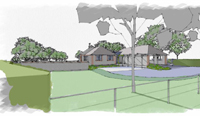 Summary: SLANT 2011 Garden Design Competition entry - landscaping of 3/4 acre rural site
Summary: SLANT 2011 Garden Design Competition entry - landscaping of 3/4 acre rural siteLocation: South Downs
Scope of work: Conceptual Plan and Visualisations

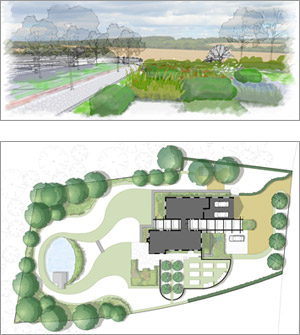 introduction
introduction
Set in an isolated rural location in West Sussex on the South Downs, the site is sheltered by mature woodlands. The house is a barn conversion, originally two single storey buildings.
proposed design
We have aimed to achieve a natural route of flow to the front entrance, whilst striving to retain some empathy with the buildings' former agricultural use. The front is fenced with iron park rails, and lined with clipped Crataegus persimilis "pruniflora" - decorative whilst not overtly domestic. Similarly, we have allowed much of the front garden to remain as uncut grass, with just a mown strip adjacent to the drive. Planting is limited to areas adjacent to the house, and is kept relatively low-key - mainly silver and purple colours, that will harmonise with the grey flint walls.
The side and back gardens are screened by hedging on the west. This rural site benefits from attractive views to the east, we have tried to bring these into the garden by ensuring the boundary is kept low, and by careful planting and design. From the dining room window one looks out through an allee of orchard trees, over a small gate, to the fields beyond. The strong directional feel is further enhanced by mowing a path through the meadow grass in the orchard.
The view from the patio to the east looks over a planting that seeks to transition, from the rectilinear blocks of Ilex crenata (similar to box) and neat mounds of Sedum "Ruby Glow", to swaying grasses - Anemanthele lessoniana and wild oats Chasmanthium latifolium - interspersed with splashes of bright red Papaver orientalis, Knautia macedonia "Mars Midget" and Lychnis chalcedonica. Even in winter the Ilex and Sedum will continue to provide some structure and interest - an important consideration for planting outside the living room.
The other principal view is to the south, where the woodland backdrop is enhanced by a pond - not very big, but just large enough to justify a small deck for a couple of chairs. It makes a nice walking route around the garden, and will be an ideal sunbathing spot, too.
- prepared for a design competition
Designing a Sussex Garden
If you're looking for further garden design ideas, there are some excellent sources of inspiration in Sussex, including:- Denmans Garden, Fontwell, West Sussex – home of renowned 20th Century garden designer John Brookes MBE, is crammed with ideas, including lots of gravel planting.
- Great Dixter, Northiam, East Sussex – 15th Century house was home to famous gardener Christopher Lloyd, but most of the garden was actually designed by the architect Edwin Lutyens.
- Pashley Manor Gardens near Ticehurst – house dates from the 1500s, but the gardens are largely the work of landscape architect and garden designer Anthony du Gard Pasley.
- Borde Hill Garden, Haywards Heath, West Sussex – 200 acres of parkland, with 17 acres of gardens including nine separate “garden rooms ” created over the last 120 years and each with its own unique style.
So, if you're wondering what to do next, why not call us for an informal chat on (01722) 714443.
Please read our Privacy Statement
